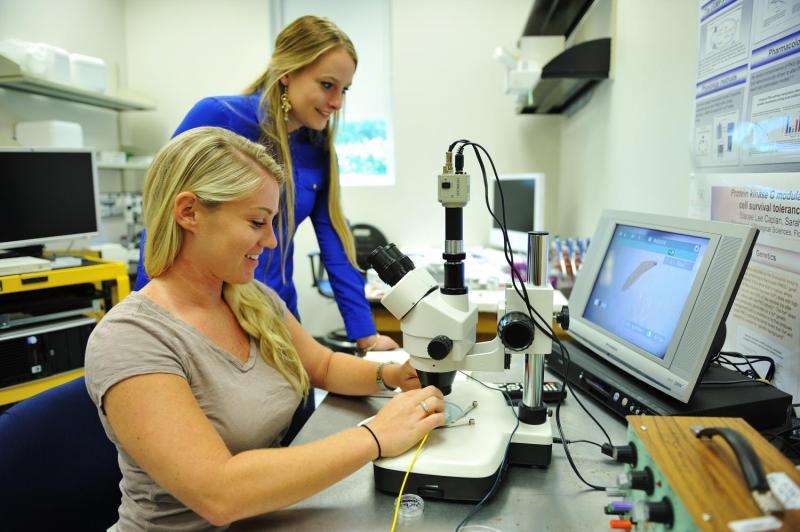Fruit flies 'push the limit' to help us understand age-related disease suseptibilities

They're pesky and annoying when they get into your fruit, but Drosophila melanogaster, more affectionately known as the "fruit fly," are helping researchers at Florida Atlantic University to discover novel genes that are responsible for neuroprotection.
In a recent publication in Nature Scientific Reports, titled "Pushing the Limit: Examining Factors that Affect Anoxia Tolerance in a Single Genotype of Adult D. Melanogaster," Monica G. Risley, a Ph.D. student working in the laboratory of Ken Dawson-Scully, Ph.D., associate professor in FAU's Charles E. Schmidt College of Science, and co-authors, had an unexpected discovery involving fruit flies, drowning and comas.
Insects enter into a deep state of sleep-like coma when deprived of oxygen caused by a slowing of their metabolism. You can see this in insects floating in a swimming pool. Have you ever wondered what happened to that insect on the side of the pool, just lying there and then disappearing? It's likely that the insect dried off, woke up, and flew away. Although this phenomenon has been previously known, the limits of insect drowning while examining age, temperature, and drowning time have finally been brought together in this FAU study.
As expected, a young fruit fly can survive up to 12 hours drowning in a puddle of water and fly away unharmed. The unexpected discovery by Risley, Dawson-Scully and collaborators was that in cold weather of 40 degrees Fahrenheit, this coma can be stretched to three full days (72 hours).
"These fruit flies are able to withstand three days of drowning by putting themselves into a reversible coma that preserves vital energy stores," said Risley. "One of the really interesting facets of our study is that age plays a major role in the drowning response. Older flies survive poorly compared to younger flies in response to this drowning stress and low oxygen."
In the recent past fruit flies have been used to successfully model a number of human disorders such as Alzheimer's, Parkinson's and obesity. They provide an ideal system to study cellular pathways associated with neural failure following severe trauma, and to help researchers develop novel therapies targeting molecules that contribute to neural dysfunction and cell death/damage.
"Adapted animals, such as insects, employ genetic, molecular, and physiological strategies to prevent specific neurological pathologies resulting from stressors such as low oxygen or anoxia, high temperatures or hyperthermia, and high levels of free radicals or oxidative stress," said Dawson-Scully.
Risley and her collaborators will take the findings from this important study and apply them to future works, using the genetically tractable fruit fly at different ages, to try and understand mechanisms of age-related disease susceptibilities and how to protect against them at the cellular level.
Journal information: Scientific Reports
Provided by Florida Atlantic University





















